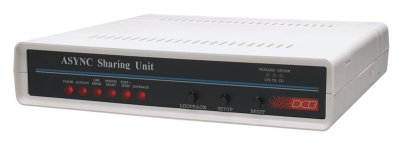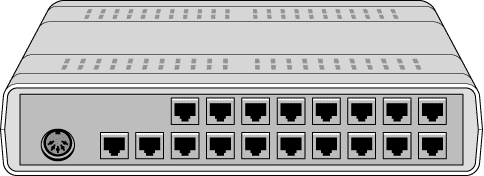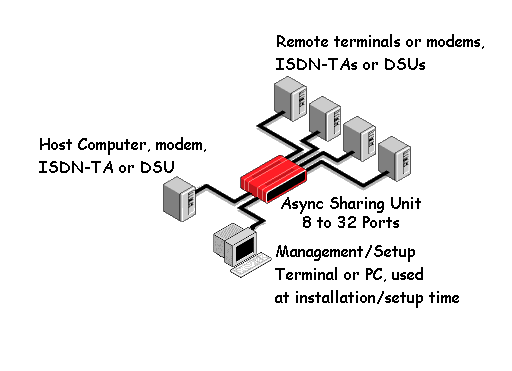The Async
Sharing Unit (ASU) shares a single data port with 4, 8, 16, 24 or 32 others.
Data received on the shared common port is broadcast to all the other ports. The
ASU makes it easy to share async polling networks. The ASU can be used with
terminal devices, multipoint modems, point-to-point modems, DSUs, over ISDN, or
over frame relay.
Async Data Sharing Unit 4 to 32
Ports ASU Async Port Sharing

|
- Share one asynchronous port with 4, 8, 16, 24 or 32
ports
- Async RS-232 interface up to 38,400 bps
- Broadcasts from 1 port to many, concentrates many
ports to one port
- Use for financial, traffic, POS, SCADA networks
- Control sharing with RTS/CTS
- Combiner mode in lieu of RTS/CTS
- Anti-streaming option
|
- Share one asynchronous port with 4, 8, 16, 24 or 32
other ports
- Async RS-232 interface up to 38,400 bps
- Broadcasts from 1 port to many, concentrates many ports
to one port
- Use for financial, traffic, POS, SCADA networks
- Control sharing with RTS/CTS
- Combiner mode in lieu of RTS/CTS
- Anti-streaming option
One method of selecting ports is using terminal device
RTS/CTS RS-232 control leads. The ASU constantly scans all ports for Request to
Send (RTS). When a terminal device asserts RTS, the RTS signal is passed from
that port to the common shared port. On the common shared port, the RTS lead is
passed out to the modem. The common shared port Clear to Send (CTS) response is
passed back to the terminal that asserted RTS. The connected device will send
data upon receiving CTS. After the terminal device completes its transmission
and lowers RTS, the scanning resumes. In the RTS/CTS control mode, data from a
port is discarded if RTS is not asserted.
The anti-streaming timer option for the ASU blocks
transmission from a port if that port holds RTS on for more than 8 seconds. This
is useful in systems that experience "hung" ports due to terminal device RTS or
modem DCD staying on in error. Turning RTS off and back on or a reset of the ASU
will reset the anti-streaming timer.
The combiner mode of the ASU is perfect for polled systems
that do not have RTS/CTS control. For example, many RTUs used in SCADA and other
control system environments are implemented with just three RS232 leads,
transmit data, receive data and signal ground. The ASU may be used at the host
end of a system, where the multiple ports are connected to line drivers, modems,
DSUs, etc, and where the Carrier Detect (DCD) signal is constantly on, rather
than switched. In these applications, the ASU combiner mode takes all data from
the ports and passes that data to the network composite without RTS/CTS control.
RTS is ignored in the combiner mode.
The ASU can be used at the remote locations where the
common shared port connects to a modem, ISDN TA or DSU. The ASU can also be used
at the host end of a network to share one host port with many modems, ISDN TAs
or DSUs.
- Rates: Async port to 38.4 kbps (9.6 kbps default)
- Application: Share one port with 4, 8, 16, 24 or 32
other asynchronous ports.
- All ports are async RS-232
- Supports data rates to 38.4 kbps
Power, Activity, Line Error, Modem Ready, Port 1 Setup,
Loopback Activity indicates incoming or outgoing data. Line Error indicates an
improper port speed. Modem Ready indicates DCD on the Network port.
Front panel push button for loopback RTS/CTS contention
control or combiner mode, anti-streaming option Side door accessible firmware
cartridge for installing firmware upgrades Setup via the "Port One Setup",
activated by the front panel push-button, or setup rear panel setup port. Use to
define port speeds, anti-streaming, etc.
Interface: RS-232, V.24, speeds up to 38,400 bps
Connector: RJ-45 per EIA/TIA 561 pin outs
Power requirements: 120 VAC, external Supply, 220 VAC
and DC supplies also available 60 Hz 8 and 16 channel units:10 c" x 9 e" x 2
c" 24 and 32 channel units: 10 c" x 9 e" x 4 c" One pound plus external power
supply

Rear view of 16 port ASU

part numbers with list price - call for discount
| ASU-04 |
4 Port ASU |
$ 595 |
| ASU-08 |
8 Port ASU |
$ 995 |
| ASU-16 |
16 Port ASU |
$ 1,495 |
| ASU-24 |
24 Port ASU |
$ 1,995 |
| ASU-32 |
32 Port ASU |
$ 2,495 |
| RK-8/16 |
Rack mount for 8/16 port unit |
$ 60 |
| RK-24/32 |
Rack mount for 24/32 port unit |
$ 75 |
Related pages
Stat Mux, Statistical
Multiplexer, FRAD, Routers,
Wireless, Remote Access,
RS-232, modems,
SCADA, and LAN interconnection
equipment
see other pages
ARC ELECTRONICS
301-924-7400 EXT 25
jump to ...
Home
Page
arc@arcelect.com


